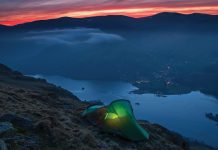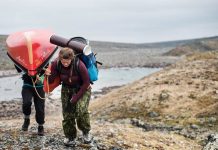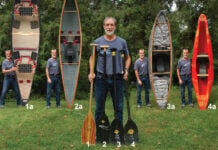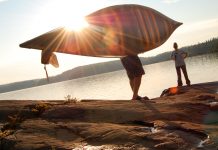Over the past decade of tripping, I’ve discovered that when minor or major disasters strike, it pays to have key items on hand immediately. An effective ditch kit holds the essentials for survival in a compact and easy-to-carry package, so you’re prepared at all times—even if you get separated from the rest of your gear, or your group. We can’t control all variables, but these basics will help mitigate many potential misadventures.
Whether on a month-long northern river trip or local day trip, the following items always accompany me, conveniently packaged in my holy sh*t kit—a bright red, waterproof and portable 10-liter dry bag. It’s never failed to avert disaster.
Stay Warm and Happy
High-density fuel sources, like chocolate and granola bars, help maintain body temperature, prevent hangriness, and keep energy and morale high.
A lighter and matches, along with waterproofed fire starter, will get a blaze going even in a torrential downpour.
Bring extra layers to bundle up an unexpected swimmer, including a warm fleece sweater, a hat, mitts and a pair of woolly socks.
In case the unexpected swimmer isn’t rescued fast enough or in case your day trip turns into an overnighter, pack a bivy bag and emergency blanket.
Fix People and Things
A mini repair kit should include the bare necessities: multi-tool, Gorilla tape, zip ties and lightweight rope. Many basic field repairs—and shelter construction—can be made quickly and efficiently with these items.
Pack a mini first aid kit. It should contain gloves, a CPR pocket mask, small bandages, gauze and sports tape, plus a wilderness first aid book, notepad and pencil. Carry a more thorough first aid kit in your camp pack. These basic supplies are at hand to address only the most critical (or common) first aid scenarios.
On Your PFD
A signalling device is important for attracting the help of rescuers in a worst-case scenario. A whistle, compass with mir- ror, and light with strobe are helpful. Even more helpful for remote trips are communication devices such as a VHF radio or satellite phone.
In a PFD pocket, keep an extra sheet of water treatment tablets and back-up map.
A knife has a hundred uses in a survival situation. Keep yours sharp and close at hand.
Fold a garbage bag in your pocket. Its multiple uses might surprise you—use it as a water container, as a not-so-trendy little poncho and—if you buy the orange ones—a handy signal flag.
Charlotte Jacklein is a teacher, trip guide and experienced adventurer.
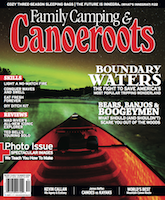
Subscribe to Paddling Magazine and get 25 years of digital magazine archives including our legacy titles: Rapid, Adventure Kayak and Canoeroots.


